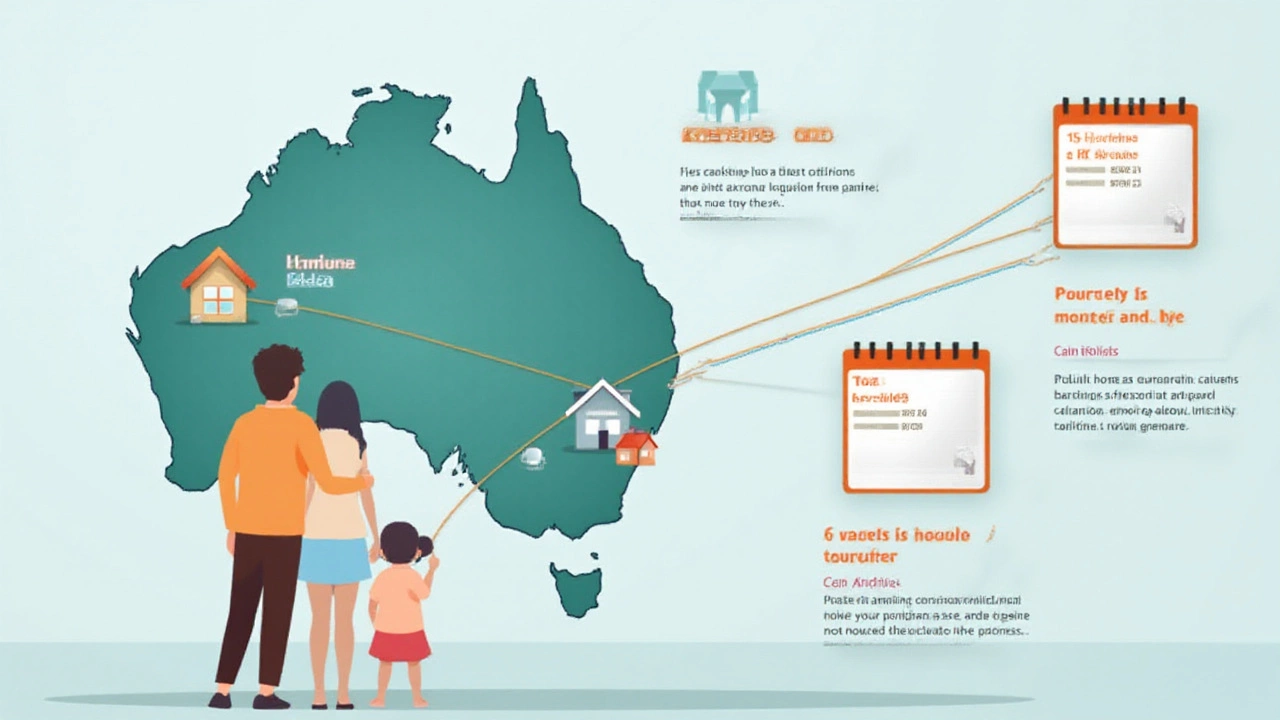Heard someone mention the “6 months and a day rule”? Maybe at a barbecue, someone bragged about dodging capital gains tax or nabbing a residency deal thanks to this rule. Or maybe a real estate agent threw it around like everyone just gets it. Here’s the thing: this single line in legislation packs a surprising punch for property owners, investors, and even expats looking to make things official in Australia. It isn’t just red tape. This rule might decide whether your property gets slammed with thousands in extra tax, or you score a much-needed exemption. So, what’s actually behind the magic numbers 6 months and a day? You might want to pay attention, even if you think you’re not one for legal loopholes.
Where Did the '6 Months and a Day Rule' Come From?
The 6 months and a day rule isn’t some ancient legend—Australian tax and residency law made it real. The phrase pops up a lot when it comes to property, capital gains tax (CGT), and, oddly enough, residency requirements for everything from the ATO to state-based land tax and stamp duty. Here’s how it happened. Australia’s lawmakers wanted a mark-in-the-sand cutoff to decide: did you really live in that house, or were you just using it as an investment? So, they landed on six months and one day—the magical minimum that makes you more than just a passing visitor.
Why not just six months? The law loves clarity. “Six months” brings all kinds of fuzzy math—was it exactly 180 days, did you leave for a weekend? By adding a day, it’s clear you really tipped into a new tax or residency bracket. For property investors and those moving in or out of the country, “6 months and a day” is shorthand for proving your real connection to a property or location. It’s significant for:
- First Home Owner Grant eligibility
- Land tax exemptions (your primary residence gets you out of tax in most states)
- Capital gains tax discounts and exemptions
- Establishing Australian tax residency status (especially for expats and migrants)
If you own property in places like New South Wales or Victoria, land tax rules look at whether you lived in your home for at least six months and a day within a year to say it’s your primary residence. For those nervous about CGT, a similar time line applies—you must actually “move in” and live there. The ATO wants proof that goes beyond paperwork (think utility bills, driver’s license, or even the presence of your couch!).
This rule’s not just an Australian quirk. The same phrase is a headache for tax residency in the UK, Malta, and even the Philippines. But nowhere does it matter more for regular folks than in Australian real estate, thanks to huge differences in tax or duty if you do—or don’t—meet that residency test.
How the Rule Affects Property Tax, Exemptions, and Residency
Let’s talk cold, hard cash. If you get the “6 months and a day” rule wrong with your property, you can wipe out savings you thought you had lined up for a new kitchen or even a family holiday. Here’s why this rule crops up again and again: taxes. Property taxes, CGT, land tax, even transfer or stamp duty, all lean heavily on the idea of “genuine occupancy” and tax residency.
For capital gains tax, the ATO loves specifics. If you claim the CGT main residence exemption—meaning, you sell your home and pocket profits tax-free—you need to have actually lived in the place for at least six months and a day, not just owned it. Selling before hitting the magic date? You might owe CGT on any profits, depending on the rest of your circumstances and the periods you actually called the house home.
Let’s go practical. Jane buys her first house in Melbourne, moves in two weeks later, and stays for at least six months and a day. She keeps utility bills, updates her driver’s license, registers to vote there—ticks all the proof boxes. Later, life happens, she moves interstate for work, and rents the old place out. When she sells years later, Jane can usually claim the CGT main residence exemption for the period she lived there, if those six months and a day at the start are clear. Flip it: if she waited too long to move in, rented it to tenants first, or couldn’t prove residency, her exemption could shrink or disappear altogether, meaning tax on capital gains.
What about residency? Australian tax residency isn’t just a vibe. The ATO’s “resides test” and “183-day rule” (which is roughly 6 months) informally use the same idea: stay longer, and you’re seen as having truly moved here. The state-based land tax system is especially picky—South Australia, for example, spells out in legislation that your property needs to be your “principal place of residence for at least 6 consecutive months” starting within a set period after purchase.
Even expats and globe-trotters run into this. If you leave Australia and rent out your family home, the exact start and end dates for the period you lived there become vital in deciding what tax you’ll face on eventual sale. Hit the 6 months and a day target and keep the paperwork, and you can sleep easy.

Common Situations Where the Rule Applies
This isn’t some rare, strange legal clause. If you’re an ordinary Aussie, you’ll probably brush up against the 6 months and a day rule more than once. It pops up especially if you’re:
- Buying your first property and claiming grants or concessions
- Switching from renting to owning
- Snagging a holiday house and thinking of moving in later
- Moving interstate for work or study
- Returning from living overseas
Let’s get specific. The First Home Owner Grant in places like Victoria and New South Wales usually says you need to occupy your new home as your principal place of residence for a “continuous period of at least 6 months, commencing within 12 months of settlement.” If you don’t, the penalties sting—repaying the grant plus interest. The same flavor of rule shows up when you try to grab stamp duty concessions reserved for “owner-occupiers.”
In Victoria, if you buy a property and get a duty concession as a first home buyer, but then don’t live there for at least six months and a day, you could lose the discount. This rule helps keep property investors from scooping up homes under the guise of “moving in” and flipping them for profit, leaving genuine home buyers priced out. The intent is clear: stability and fairness for people who actually live in their homes.
Now, for those with a family home here in Australia but who move away as expats, keeping ties to your property is huge. Long absences with the home rented out can look fishy to tax authorities. Many get caught out when they return to sell, thinking their home is fully CGT-exempt, only to be told the clock ran out on that exemption unless they’d met the 6 months and a day rule initially. Maintaining records—school enrollments, mail changed to the address, utility bills in your name—can all act as proof for the ATO’s close look.
If you plan to turn an investment into your home, or the other way around, mark your calendar and keep all supporting documents. Examples abound online of people losing tens of thousands over a missing document or missed timeline. If ever in doubt, talk to a tax adviser well before listing your property or applying for grants—you don’t want to find out you missed out by a day or two.
How to Prove You Meet the 6 Months and a Day Rule
Anyone can claim, “Yes, I lived there!” Actually proving it, though, is a different beast—a favorite pastime of auditors and tax officials. Gaps in your story, like a mismatch between electricity usage and your claimed move-in date, can land you in hot water. So, how do you nail down your eligibility if the tax office comes knocking or if you want that sweet land tax or stamp duty exemption?
First, start living like you really mean it. That means moving in physically, not just legally. Update your driver’s license to the new address. Redirect your mail—especially from your bank, ATO, and any government services. Set up utilities in your name and keep those first bills. If you have kids, enrolling them in local schools is solid proof.
Keep digital breadcrumbs. Bank statements showing consistent spending near your new home can help, as do public transport cards or even gym memberships nearby. If authorities ask, you can whip up serious evidence with:
- Utility bills (electricity, water, gas) covering each of the six months and a day
- Driver’s license, Medicare, bank, or electoral roll address change confirmations
- Signed letters from neighbours or your property manager
- Correspondence and receipts tied to your move, like removalists invoices
If you split your time (say, travel for work or help out a relative in another city), you’d better keep a diary or other proof showing the new place was really your “main base.” Occasional nights away aren’t usually a problem, but extended absences can mess up your claim. Some states even detail what counts, with lists of documents to gather. For the First Home Owner Grant and similar exemptions, state revenue offices conduct random audits—so got the files handy or risk giving the money back.
Paperwork aside, patterns matter. If your utility use drops to zero or you don’t have internet set up, it’ll look like you never moved in. Tiny details, like being registered with local healthcare or taking part in local events, all help build your case. With home prices and taxes so high, missing out on an exemption because you didn’t “live there enough” can be gutting. So, treat the 6 months and a day rule not as a formality, but as a clock that starts ticking the moment you get the keys.

Practical Tips for Navigating the Rule (and Avoiding Painful Mistakes)
No one wants to lose a five-figure tax break or face a government clawback just because they missed some fine print. Here’s how you can make the 6 months and a day rule work for you and dodge trouble down the track:
- Start your residency clock right after settlement or as soon as it’s possible to move in. Don’t delay.
- Keep digital and paper copies of every document from the move date and for 6+ months—especially utilities, mail, and proof of address changes.
- If your situation’s complicated—maybe you travel a lot for work or split time between homes—keep a regular diary, calendar records, and anything else to show genuine occupation.
- For city moves, registering your vehicle at the new address, signing up for local council services, or even joining a sports club can tip the balance if the tax office asks for proof.
- If you must leave during your initial 6 months (say for travel or family emergencies), document your reason—keep tickets, emails, or a medical certificate. A short absence usually won’t blow up your claim if you come back to your main residence.
- When in doubt, talk to a property-savvy accountant before you move in or rent out your property. Once you’ve missed the deadline, not much can be done.
- Don’t fudge details on grant applications—revenue offices have stepped up audits and data-matching in recent years, and penalties are tough.
Nothing’s worse than thinking your forever house is “tax-free,” only to learn years later that a technicality costs you thousands. The cost of getting expert advice upfront is nothing compared to losing exemptions or facing a bill for years of unpaid land tax. It’s not paranoia—random spot checks really do catch people every year, even when they swear they “just forgot one thing.”
The “6 months and a day rule” might seem like legal trivia, but it can shape the outcome of your property journey. Whether you’re buying your first home, going global as an expat, or turning your investment into your family nest, getting this rule right makes all the difference. The boring paperwork? Turns into real money saved. You won’t regret spending an extra afternoon getting the details sorted. Your bank account will thank you later.
